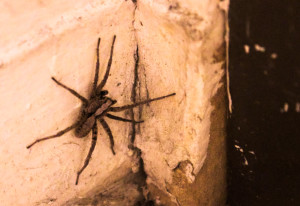Tags
Related Posts
Share This
Crawlers
If it’s cold outside, then the crawlers are coming.
First of all, The College of Santa Fe was build on ant colonies, and though they’ve been routinely poisoned, they have yet to be terminated. Second, we live in rural New Mexico. Be glad we don’t have rat problems. Third of all, Ecolab Pest Elimination employee Anthony Dion says that the key to keeping ants, spiders and mice out of dorms and apartments is “sanitation” and securing window and door frames. Peter Romero, director of Facilities and Security, adds that leaving sugar or syrup exposed on surfaces “is like ringing a dinner bell.” Lastly, because a majority of insects “can’t live in the cold,” student and insect enthusiast Chris Stahelin suggests keeping relatively cool temperatures indoors.
Keep clean. Keep closed. Keep cool.
“Bugs in this part of the country start migrating indoors during weather changes,” Romero says. “It’s just that time of the year. We’re proactive about treating affected areas, but basically it comes down to personal responsibility and keeping clean. It doesn’t mean using bleach, but most students eat things that are sweet and that is a magnet for ants. It’s a magnet for a lot of things.”
Because facilities like the cafeteria must pass environmental inspections, Romero explains that not only are these facilities regularly cleaned but they undergo monthly maintenance services by contracted companies.
“We have a lot of sensitive students so we have to be very careful the type of chemicals we use,” Romero says. “We use stuff that’s very mild, because as it is we get criticized for using too harsh of cleaning products.”
Since switching companies to a local branch of Ecolab last semester, Romero adds that the campus has tried to use more “green products.” For example, instead of spray, facility workers have installed “little houses” along the dormitory to trap mice. Only in extreme cases does the situation call for evacuation of residents. In order to avoid such extremes, Romero says the best thing to do when you begin to see clusters is “report it.”
Of course, there are cases of unexpected infestation. SFUAD students Amelia Wilson and Miranda Bass, for example, were evacuated from their on-campus apartments for three days due to an un-welcomed parade of cucumber beetles.

Apartment C6 suffered an extensive bug infestation, which forced the residents to be moved from the building for several days. Photo by Amanda Tyler
“They’re teeny tiny and they have these white lines on their back,” says Wilson, who explains that she and her roommate Bass were seeing the beetles at the beginning of the semester, but only a few at a time. Earlier this month, however, the roommates walked into a swarm of them in their living room.
“There were at least 200 bugs all on this one wall,” Wilson says, “and all over our fan, and all over everywhere. Because our windows aren’t sealed all the way, we think they were coming in through there.”
According to Wilson, the terminator assigned to their apartment didn’t fumigate, but executed the eco-friendly pest maintenance. Upon moving back in, the roommates had a cemetery of beetles to clean up.
And though the beetles have since reduced in number, Wilson says that she and Bass still use Raid and keep the bottom of their window frames duct taped for extra protection.

The roach killer used by residents of the on-campus apartments in an effort to control their bug infestation. Photo by Amanda Tyler
Ecolab employee Dion, who takes care of monthly preventative maintenance, describes the company’s use of bait, barriers and gels as eco-friendly and non-toxic. For ants, however, Dion admits that “there is no way to get them all.” Instead, Dion explains that the food lure is the most effective method, essentially using cans of syrup to attract and trap the ants until he collects them upon next inspection.
Spiders are another story. Since his arrival at SFUAD four years ago, student Chris Stahelin has been “hunting” and “cataloging” insects on campus. “When it comes to insects we have everything from centipedes to praying mantises.”
The most talked about of the arachnid family, however, is the black widow. Hanging in doorways, along benches and in the dark crevices of our walls, the black widow is haunting but harmless—according to Stahelin—when left alone.
“Black windows were everywhere my first semester,” Stahelin says, recounting the 15 he and his friends found in boiler rooms and among pipes or the 80 he counted this year around Saint Michael’s Hall.
“They’re blind, first of all,” Stahelin says, “they are seclusive and they primarily live in the dark.” But despite their scary appearance, Stahelin explains, most black widow bites are accidents. “We haven’t had a bite here on campus yet, which is surprising and good. It’s one reason why I don’t kill scorpions and centipedes, because they are the ones that eat the spiders. I let them be.”







 Jackalope Magazine is the student magazine of Santa Fe University of Art and Design. Building on the interdisciplinary nature of our education, we aim to showcase the talent of our university and character of our city.
Jackalope Magazine is the student magazine of Santa Fe University of Art and Design. Building on the interdisciplinary nature of our education, we aim to showcase the talent of our university and character of our city.
Recent Comments